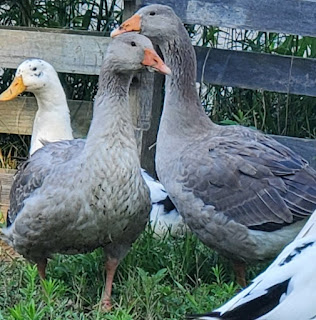Before we went with Pilgrim Geese we had raised American Buff Geese. Other goose breeds we had considered raising were Cotton Patch, Shetland, Pomeranian, and Roman. We search for Cotton Patch and Shetlands and never found any breeders that responded to our inquiries on purchasing hatching eggs or goslings from them.
Pomeranians and Roman while were much easier to purchase were knocked to the lower end of the list when I found Pilgrims available near me. We may in the future look at adding a second goose breed. Pomeranians are a good possibility as well as Shetlands, Romans and Cotton Patch. For now I will discuss Pilgrim Geese.
I have found Pilgrim Geese to be calm, quiet and pretty docile (unless it is breeding season some males can get protective). The are good foragers which means they don't need much commercial feed. Pilgrim Geese are listed as threatened with the Livestock Conservancy. They lay 35 to 45 large white eggs a year. The main use of this breed of goose is for meat. They reach market weight of 10 to 12 lbs. in about 10 to 15 weeks. These are a excellent medium weight goose for the backyard flock.
They are excellent parents. Rearing their young without human intervention. They are sexually dimorphic you can sex the gosling from a visual inspection. Males at hatch are yellow/silvery with light colored bills. Females are grayish with darker colored bills. Adult males (called ganders) are mostly white with blue eyes, orange bills and legs. Females (called geese) are grey with dark brown eyes, orange bills and legs.
The proper ratio of males to females for reproduction purposes is 1 male to 3 to 5 females. Breeder should be selected for a sweet temperament, full plump bodies, a smooth keel-less breast, an average length neck, broad back. Breeders should not have long necks, shallow breasts, long legs, a knob (usually from crossbreeding) or wrong feather coloring. .
Dave Holderread is the premier expert on waterfowl. He wrote a book on geese breeds that can be found here The Book of Geese: A Complete Guide to Raising the Home Flock. Hen House Publications. is the title of the book in case it is not available through amazon. He also wrote a breed specific bulletin available on his website.
http://holderreadfarm.com/literature_page/literature.htm
Holderread no longer raises waterfowl. I am at this time not sure if you can still get his books or other publications.



